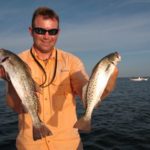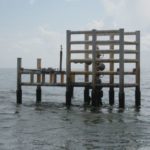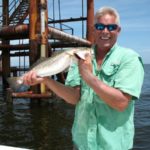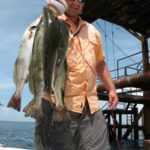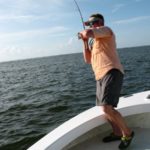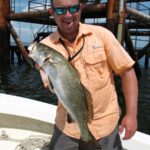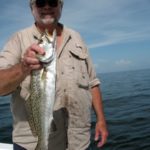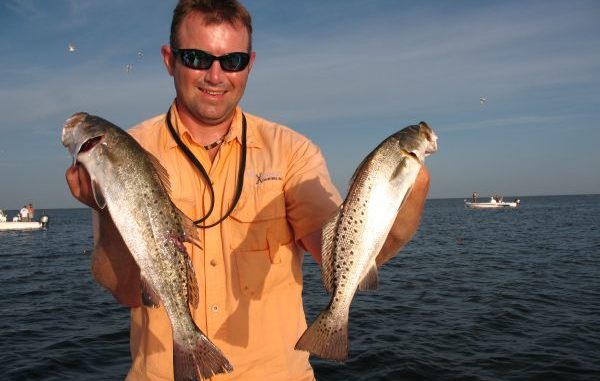
Trout move out of the marshes and into the big, open water of Breton Sound. Putting together a box of fish is a matter of hitting enough spots to find where the specks are hiding.
Mention the word “August” to anyone who lives in Southeast Louisiana, and several thoughts immediately come to mind. None of them are exciting.
For most, we associate August with sweltering heat and the kind of humidity that makes anything you wear sag over you in a sweaty drape.
Kids think of it as the end of summer and the return of another school year.
Even fishermen debate whether to get out on the water this month, balancing the potential reward against the intense heat and humidity.
August also increases our potential of tropical weather (who can forget Hurricane Katrina’s visit back in August 2005?) and those regular visits by afternoon thunder-boomers.
This month presents some challenges, to be sure. But anglers willing to alter their usual tactics and play some hit-and-run-style fishing can find August to be a productive month.
I recently had the opportunity to jump aboard Capt. Jonathan Sanchez\’s boat for just such an excursion into Breton Sound, and found myself in some good company: Glenn Sanchez, owner and operator of Hopedale’s Breton Sound Marina and Capt. Jonathan’s dad, was already aboard and former Breton Sound Marina owner Mike Perry was also along for the trip.
I loaded my gear onto the younger Sanchez’ 25-foot Privateer a good 30 minutes before daylight, and he cranked the 300-horsepower Yamaha four-stroke and pointed the bow south down the Spoil Canal toward the outside waters.
Jonathan Sanchez said there are several keys to success when the Louisiana heat cranks up.
First on his list is getting a very early start.
“Either fish early or fish late this month,” Sanchez said. “The water will heat up fast, and the bite will slow down dramatically.
“Right now, the fish are feeding very early in the mornings and very late in the evening, so you want to be fishing when they’re feeding. Many times we find they stop feeding by 7 or 8 a.m. Then it’s over.
“You can hang out for hours and pick up some stragglers here and there, but the fast bite that puts a bunch of fish in the box is basically done until evening.”
He said the late-risers among us miss the bite altogther.
“This is not the month to leave the dock at 7 or 8 in the morning,” Sanchez said. “Save that sleepyhead fishing for cooler months. This is the dead heat of summer, when the water is the warmest it’s going to be all year; the winds don’t usually blow as much in August, and unless we get some rain to cool things down briefly, that water heats up like soup.
“The point is, go early or go late. Personally, I prefer fishing the early mornings. But the late afternoon bite can be very successful, also.”
But evening fishing is limited, he said.
“You have a shorter window to fish in the evening, but the fish often bite as good if not better in the couple hours before dark, at all the same places,” Sanchez said.
After the meandering ride down the Spoil Canal, he turned the boat into the Ship Channel and ran out along the rock jetty before veering off through the cut in the rocks.
Which brings up Sanchez’s second tactic: Be prepared to run farther.
“As a general, the colder it is, the closer in we fish, and the hotter it is, the farther we fish,” he said. “In colder weather the fish move in, go deep and huddle; and in the heat of summer, they go outside, go deep and gang up.
“You have to go prepared to do some running and burn some fuel. Top off your tank, load up the baitwell and head straight for the big water.”
I could tell by our direction that we were headed toward a popular summer hotspot the locals call 5 Wells, which apparently got its name long ago from a group of wells.
Today, the area is characterized by two large rigs, both of which hold fish and are very popular destinations for local anglers.
There are a few small wellheads nearby that can hold some bull reds, but Sanchez said specks gravitate toward the big rigs.
On weekends both structures can be surrounded by boats, but on this early weekday morning, with the sun just beginning to break, we were its only customers.
Sanchez bypassed the closest rig and slowed down in front of the one lit up like a small city. Unfortunately, a jack-up boat was parked next to the dock, and its motor was running as if preparing to shove off. The roar of big motors and the churning of big props isn’t conducive for good fishing, and to make matters worse a powerful tide was roaring through the legs of the rig.
“Too much tide is just as bad as no tide,” Glenn Sanchez said, looking at the big jack-up boat now in reverse and backing slowly away from the rig. “I don’t know if we’ll be able to catch any fish here.”
His son positioned the boat a good distance down current from the rig and pulled out a custom-made, super-heavy-duty Cajun anchor and threw it like a javelin to the water bottom, where it stuck fast and held the big boat, even in the swift current.
“You can’t drop an anchor out here without snagging the bottom, and to fish as far back from the rig as we are with a rig hook is impractical, so this is the best option,” Jonathan Sanchez said.
“Do you always fish this far off the rig?” I asked, because we were so far back you’d never be able to cast far enough to reach the rig.
“Only when the current is real strong,” he said. “On a slight tide, I’ll fish right next to the rig. But I find the stronger the tide, the farther back the fish are off the rig.”
And to accentuate the fact, he cast away from the rig, even farther down-current. We were using live shrimp, bottom-rigged or, in my case, on a sliding cork.
We fanned our casts so we surrounded the boat with live shrimp. But either nobody was home, or they just weren’t interested.
Ten minutes later Jonathan Sanchez cranked the outboard.
“Let’s go; we’ve been here too long already,” he said.
Which brings us to the third tactic: Hit and run.
“I describe the fishing action this month as feast or famine,” Sanchez said. “Either the trout are there and will eat up your baits and stack up in your ice chest, or they’re just not there at all.
“It’s also possible that you come across small schools of just a few fish or even a lone straggler. It happens.
“But usually I find that when you do get on a good bite there’s going to be a lot of fish there. They do gang up in August, so your plan should be to move until you find them. That means you have to be prepared to play hit-and-run this month — that is, hit a rig, fish it for 10 minutes or so and if nothing pops, run elsewhere. You can’t hesitate to pull up and head out.”
The key is to balance how long to stay with any fishing action.
“If you do catch some fish, naturally you’ll want to give a spot a little longer to produce even more,” Sanchez explained. “But do not fall into the trap of sitting too long at an unproductive spot. You only have a short window to put fish in the boat, so you have to wring as much productivity as possible out of your limited time.”
Obviously, however, moving eats up time.
“Of course, there’s always another mistake we often make: We leave fish to go try to find fish,” Sanchez said. “We may be catching small fish, keepers, but not big, and we’re tempted to pull up to search for bigger fish. Or, we’re catching some fish, but the action is slower than we\’d like.
“Do we stay put and continue to put fish in the boat, even if it’s kind of slow? Or do we leave biting fish to go look for fish?”
It’s a case-by-case decision.
“Me, I leave such decisions to my customers,” Sanchez said. “It depends on what they want to do. If they\’re big-fish hunters, we\’ll leave small fish to hunt the big ones. But if they just want to put fish in the boat and they\’re content to fill the box slowly, we stay put.
“Every boat has to make that call: Do we stay, or do we go? But if nothing is biting, it’s a no-brainer: Go.”
Sanchez pointed the bow in a direction that could only mean one thing: We were headed to Breton Island.
A relatively short boat ride later we pulled up to the big island, where two other boats were already fishing. Breton stretches out for a few hundred yards so there’s room for all, but most boats tend to congregate around the old Kerr-Magee ruins that offers structure other than sand.
Here, we fished our live shrimp under popping corks and on sliding sinker rigs, and both were successful. Speckled trout starting sailing over the gunnel into the boat, along with a few trash fish we tossed back.
But these trout were smaller than expected, and after 15 or 20 minutes I could tell the younger Sanchez was wrestling with the question that he\’d have to answer for himself today.
“Do we leave fish to find fish?”
The whole time we fished, more boats kept arriving, and soon a small armada had gathered around this stretch of the island.
“One last cast, and we’re pulling out,” Sanchez said, hoping nobody would catch another fish and then want to stay longer.
We reeled in and up came the Power-Pole, and off we went to seek bigger quarry.
Which brings up Capt. Jonathan’s fourth tactic: Fish deep.
“Even when we fish around the islands (Breton or Gosier), we fish deeper this month,” said Sanchez. “The fish are not going to be up against the bank, so don\’t think you have to try to get in close to catch fish. Notice the wade fishers: They wade out as far as they can and fish away from the island.
“Boaters try to get up as close to the island as they can and then fish toward it. The fish are hanging off the island in the deeper water along the sandbars, especially in this August heat.”
From Breton, we ran to Gosier and fished in several spots about 40 or 50 yards behind the waves breaking over the shallow shoal. We fished in water ranging from 4 to 6 feet deep at the island, but mostly caught only ladyfish.
Ladyfish can fight better than anything its size, and when hooked they put on a great aerial display. But they’re worthless as table fare, and you never want to swing one aboard: The instant you swing a ladyfish over your gunnel they expel everything in their bowel and violently flap it all over your boat — and all over you. It\’s a mistake you only have to make once.
Of course, ladyfish aren’t the only trash fish you have to contend with this month. Add hardheads, shark, bluefish and a host of others. The jury is still out on whether to include Spanish mackerel among the trash fish.
From Gosier, we went back to rig hopping and made several stops mostly at larger structures in water 15 to 18 feet deep until we finally found a concentration of nice specks.
Live shrimp on sliding sinkers or sliding corks set just above the bottom were the winning ticket, but Glenn also put some nice fish in the boat on plastic eels. He said the Norton Sand Eels or MirrOlure soft-plastic Provoker Eels in opening night will attract the bite in deeper water, especially once a good bite gets going.
Sanchez said he has also had success with the Matrix Shads in either the creole shrimp or magneto colors.
The real key — and Sanchez’s fifth and final tactic — is to try everything.
“Usually, when I’m fishing a rig I’ll hook on with my rig hook and adjust my rope according to the tide,” Sanchez said. “Slack tide, fish very close to the rig. The more the tide, the farther back I fish downcurrent off the rig. But you have to try everything, including anchoring upcurrent and fishing back toward the rig. You have to try every trick you can.
“Fish with a heavier weight or a lighter weight. Personally, I like to fish with the lightest weight I can: Toss your bait free-line or with just a split-shot. Fish under a cork, and come with some sliding corks prerigged.”
He said he couldn’t stress enough the importance of being flexible.
“Fish can be weird at times, and sometimes they’ll hit a bait only if it’s rigged a certain way, so you have to try everything,” Sanchez explained. “And always have live bait aboard. You’re spending a lot of time and money on fuel to fish out here, so don\’t skimp on the bait which is always going to give you the best chance for success.”
And, again, if you\’re planning to do the Breton Bounce this month, plan to hit all the big rigs until you find some fish.
Sanchez said Central, Holy Cross, the Compressor, 5 Wells, 32 and the islands should all hold fish.
You can also do the bounce in Black Bay at all the rigs and structures from Stone Island to Battledore Reef.
“And if you launch out of Hopedale or Shell Beach, you can try the rocks along the MRGO on the way in,” Sanchez said. “They still produce, even in the heat of August.”
Editor’s Note: Capt. Jonathan Sanchez can be reached at 504-232-6227.
Destination Information
We launched out of Hopedale’s Breton Sound Marina, about an hour\’s drive from New Orleans.
Directions:
Take I-10 east from downtown and exit on I-510 south (Paris Road). Turn left on Highway 39 (Judge Perez Drive) and follow it over the Violet Canal overpass to the blinking light at the four-lane intersection just before the intersection with Highway 46.
Turn left on the four-lane and go about nine miles to the four-way stop. Turn left and drive about five miles, cross the drawbridge bridge and take a right onto Highway 624 to Hopedale.
Marinas
Breton Sound Marina has a double backdown, a hoist, ice, live bait, accessories and a nearby fuel dock.
Campo’s in Shell Beach has a double backdown, ice, fuel, accessories and live bait.
Guides
Several guides fish out of Hopedale and nearby Shell Beach. Check the LouisianaSportsman.com business listings or call the marinas for recommendations.
Overnight accommodations are available in both Hopedale and Shell Beach. Check with the guides and marinas for more details.
